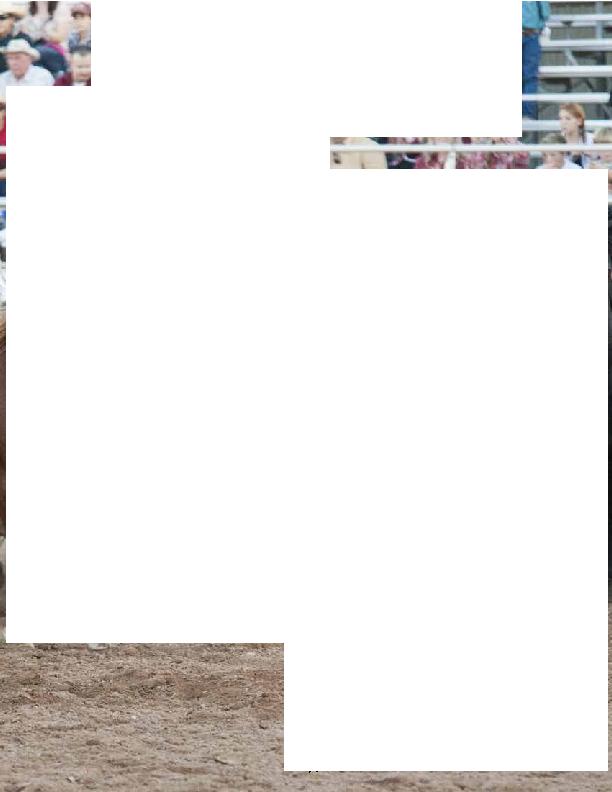
Brawley Chamber of Commerce
Brawley Cattle Call
45
Humane Facts
PCRA animal-welfare guidelines set standards for
Rodeo
Members of the Professional Rodeo Cowboys Association
believe, as do most people, that animals should be treated
humanely. The PRCA established rules regarding the
humane treatment of animals in 1947, long before
animal-rights organizations targeted rodeo. Those rules
have been continually updated, and new regulations have
been added. Today the PRCA strictly enforces nearly 60
rules geared speci cally toward the humane treatment of
rodeo livestock. In addition, PRCA rules require that all
sanctioned events are sta ed by an attending veterinarian.
Animals used in professional rodeo competition are top
athletes. "Only when horses and bulls feel good will they
buck good, and basically in timed events it's the same
way," said Shirley Churchill, supervisor of timed events at
Cheyenne (Wyo.) Frontier Days. "The fastest time or best
score requires the best stock."
By inspecting every animal before it is selected for compe-
tition, the PRCA ensures that only healthy livestock is used.
If an animal becomes sick or injured between the time it is
drawn and the time it is scheduled for competition, it will
not be used. As to further protect the animals, PRCA
o cials are authorized to disqualify a contestant and levy
a $250 ne on the spot for unnecessary roughness.
Who takes care of the animals?
PCRA rodeos are managed by people who are knowledge-
able and well educated about proper livestock handling
and maintenance. There are few more attuned to the
animals' needs than the professional stock contractor. "The
rst thing the stock contractor does (after a rodeo perfor-
mance) is make sure those animals are fed and watered,"
said Tommy Keith, a PRCA judge. "He probably hasn't
eaten since 7 in the morning and he's been out here
working all day, but he makes sure those animals are taken
What is a ank strap?
The ank strap is a sheepskin-lined strip of leather that is
placed behind the horse's rib cage in the ank area. The
strap enhances the bucking instincts of an animal, but
causes no pain. PCRA rules strictly regulate the use of the
strap, which must have a quick-release buckle. Sharp or
cutting objects are never placed between the strap and
the animal. Veterinarians have testi ed that the ank strap
causes no harm to animals. "I've never seen or heard of any
damage caused by a ank strap, and as for the argument
that it covers the genitals, that's impossible," said Dr. Susan
McCartney, a veterinarian from Reno, Nevada, who
specializes in large-animal care. She also says, the horse's
kidneys are protected by its ribs, and the ank strap
doesn't injure internal organs.
So, if not for the ank strap, why do horses buck?
The answer is simple: Instinct. Bucking is often part of a
horse's nature, and a horse that is not inclined to buck
cannot be forced to do so with the use of a ank strap.
"These are not animals that are forced to buck and
perform out in the arena," said Dr. Eddie Taylor, the attend-
ing veterinarian for La Fiesta, de los Vaqueros, a
PRCA-sanctioned rodeo in Tucson, Arizona. "They
thoroughly enjoy what they are doing."
Do rodeo cowboys use spurs?
Dull spurs are used in professional rodeo's three riding
events: bareback, saddle bronc, and bull riding. Spurs that
meet PRCA guidelines have blunt rowels (the star shaped
wheel on spurs) that are about one-eighth of an inch thick,
so they can't cut the animals.
What is a cattle prod?
The cattle prod was developed by the cattle industry as a
means to move livestock. Use of the prod has become one
of the most universally accepted and humane methods of
moving animals on ranches, in veterinary clinics, and
occasionally at professional rodeos. Powered solely by
ashlight batteries, the prod produces 5,000 to 6,000 volts
of electricity, but virtually no amperage. And because
amperage -not voltage causes burns, the prod causes
mild shock, but no injury.

